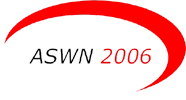
Applications and Services in Wireless Networks
Berlin. May 29-31, 2022
Technically sponsored by IEEE TCPC of Communication Society

Sponsors
Committees
Call for Papers
Authors Guidelines
Venue & Travel
Accommodation
PDF: Advance Program
 |
6th International Workshop on Applications and Services in Wireless Networks Berlin. May 29-31, 2022 Technically sponsored by IEEE TCPC of Communication Society |
|||||
 |
||||||
| Contact Sponsors Committees |
Program Call for Papers Authors Guidelines |
Registration Venue & Travel Accommodation |
PDF: ASWN Flyer PDF: Advance Program |
|||
Digital Detox in Schools: Balancing Education and Screen TimeI. IntroductionIn a world where screens seem to have become our constant companions, picture this: a classroom filled with students fully engaged in learning, their eyes not glued to devices, but to the words of their teachers and the world around them. It might sound like a distant dream, but it's a dream that educators, parents, students, and technology enthusiasts are working towards. In today's digital age, where screens dominate our lives, the issue of screen time in schools has gained prominence. It's a topic that concerns us all—educators shaping the future, parents nurturing the next generation, students navigating the digital landscape, and technology enthusiasts envisioning the possibilities. This article delves deep into the realm of "Digital Detox in Schools," exploring its significance, the impact of digital devices on education, and practical strategies for achieving a balance between technology and traditional learning. II. The Impact of Digital Devices on EducationThe Digital Revolution has ushered in a host of benefits for education. It has transformed classrooms into dynamic hubs of learning, providing access to a world of knowledge at our fingertips. But with great power comes great responsibility. While technology brings numerous advantages, including personalized learning and interactive resources, it also poses challenges. Excessive screen time can lead to reduced attention spans, digital distractions, and concerns about the mental and physical well-being of students. According to recent studies, the average screen time for children and teenagers has surged, raising questions about the long-term consequences. Students are particularly affected by excessive use of gadgets, especially when there is a large amount of academic work to be done. Therefore, in order to shorten the process of searching for the necessary information in search engines and its processing, you can entrust several tasks at the same time to the authors of the outline writing service https://exclusive-paper.net/do-my-outline-for-me. III. Understanding Digital DetoxDigital detox in the context of education isn't about abandoning technology; it's about finding a harmonious blend. Digital detox aims to achieve several critical goals, including promoting focus and deep learning, reducing digital distractions, and nurturing offline skills. It's a holistic approach to education that recognizes the need for balance in a technology-driven world. IV. The Role of EducatorsEducators are the architects of this balanced learning experience. They play a pivotal role in striking the right balance between technology and traditional teaching methods. By incorporating tech thoughtfully, educators can create engaging lessons that enhance learning without over-reliance on screens. Success stories abound, with teachers who have harnessed technology effectively, such as gamifying lessons and utilizing educational apps to reinforce concepts. V. Tips for ParentsParents, too, are instrumental in the digital detox journey. Parental involvement is crucial in managing screen time. Establishing boundaries, monitoring device use, and fostering open communication with children are essential steps. Additionally, parents can encourage a healthy balance between technology and other activities, such as physical exercise and face-to-face social interactions. VI. Student PerspectivesThe voice of students is invaluable in this discourse. Students who have experienced digital detox offer unique insights. They share the challenges they face in reducing screen time and the benefits they derive from the experience, such as improved focus and enhanced creativity. Empowering students with strategies to manage their screen time effectively is key to their growth. VII. Technological SolutionsTechnology provides solutions as well as challenges. Various tools and apps are available to help educators and parents manage screen time effectively. From screen time tracking apps to classroom management software, these tools can promote a balanced and productive learning environment. Features that encourage offline activities and mindful screen use are especially valuable. VIII. Best Practices from SchoolsSuccess stories illuminate the path. Schools and districts worldwide have successfully implemented digital detox programs. These case studies demonstrate the strategies employed and the remarkable results achieved. They serve as inspirations and roadmaps for others striving to find the right balance. IX. Balancing Act: Finding the Right MixThe essence of digital detox is balance. It's essential to emphasize that digital detox does not mean eliminating technology from education. Instead, it's about integrating technology purposefully and mindfully into the curriculum. Striking the right mix is the key to a holistic and effective education. X. The Future of Education and TechnologyAs technology evolves, so must our educational approaches. Exploring emerging trends in educational technology, such as virtual reality and AI-driven learning, offers a glimpse into the future. Schools must adapt to these technological advancements while maintaining a steadfast focus on student well-being and balance. XI. ConclusionIn closing, it's evident that the concept of digital detox in schools is both timely and essential. We've uncovered the impact of digital devices, the goals of digital detox, and the crucial roles of educators, parents, and students. We've also explored technological solutions and real-world success stories, all while emphasizing the need for a balanced approach. Digital detox is not just a challenge but an opportunity to reshape education for the better. Let's actively participate in this conversation and work together to implement positive changes in our educational environments. |
| Last modified: 2022-01-12 19:42 |